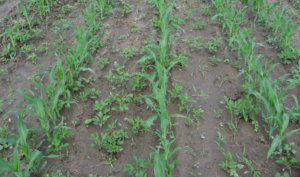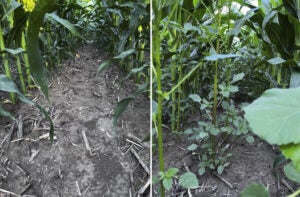Most of us were taught at a young age not to take things that don’t belong to us. Weeds seemingly never received such a lesson.
Notorious for stealing soil nutrients, moisture, and sunlight from neighboring crops, stubborn weeds cost American farmers time, money, and labor, thus negatively impacting their operations. This challenge is nothing new: The first modern herbicide dates back to the mid-1940s, and the technology has evolved in the generations since — as have the strategies.
The most effective herbicide regimens include what are commonly referred to as residual herbicides. They target weeds at the pre-emergence stage, while also capable of long-lasting activity in the soil.
“Weeds are more vulnerable to control when they’re just seedlings versus when they become a large weed,” said Shawn Hock, Product Lead for Corn Herbicides with Syngenta, the leader in residual herbicides. “Early-season weed control gives corn the best yield possible, because maximizing that genetic potential is really important. Controlling weeds at that stage allows the most light and nutrients to be captured and keeps early-season interference from happening.”
Because of the lost yield, waiting to address weed pressure can be very costly.

Cutting-edge research from the University of Guelph in Ontario has quantified corn’s ability to detect the presence of neighboring weeds through changes in light quality. The detection of neighboring weeds by the corn seedling can result in fundamental and detrimental changes to plant development, for example, leaf orientation. When pressured, a corn plant often will pour more energy into upper canopy growth to try to outcompete the weeds.
These shade-avoidance responses are just one piece of weeds’ influence. The early presence of neighboring weeds will lead to taller corn plants, reduced biomass, delayed development, and fewer kernels per plant. This can result in a corn plant vulnerable to water stress and other unfavorable growing conditions. The corn is therefore unable to build yield later in the season.
Syngenta has worked with Dr. Clarence Swanton and his colleagues at Guelph’s Department of Plant Agriculture for years to explore the benefits of residual herbicides, building off a foundation that the company has been employing for over 65 years since the introduction of atrazine herbicide. Syngenta’s latest corn herbicide is Storen™, which was registered by the U.S. Environmental Protection Agency over the summer and will be available for use in 2024, subject to state approvals.
“We were one of the few agricultural companies that didn’t focus investment solely on post-emergence contact weed control, and now with weed resistance becoming more and more of a problem across more acres, our story rings even truer,” said Chris Munsterman, an Agronomic Service Representative who’s been with Syngenta for more than two decades. “The only way to stop a weed is to never let it sprout. And we’ve got to manage that pressure before it becomes too much to handle.”
One of the agricultural industry’s most notorious weeds, Palmer amaranth, is a voracious user of nitrogen, potash, and water, and while a lone plant from the Amaranthus species may not seem like a problem in the field, a single female Palmer can shed upward of 600,000 seeds, sparking areas of high weed densities and creating tremendous yield losses.
Field trials point toward Storen as a vital pre-emergence herbicide against Palmer amaranth, while also offering superior coverage against giant ragweed and annual grass species like barnyard and foxtail, among others. This is especially poignant as agronomists note that more non-GMO corn is being planted in fields where they don’t use glyphosate, so a consistent and longer-lasting residual is key.

AAtrex 4L is a Restricted Use Pesticide.
Further bolstering its investment in pre-emergence products, Syngenta’s research has shown that glyphosate-resistant Palmer amaranth is able to easily metabolize today’s post-emergent herbicides, and the most effective management approach is to keep these weeds from ever coming up, hitting them when they’re susceptible just before popping through the soil surface.
Experts say that even if a producer comes in weeks later to try to kill those weeds, it’s likely the yield damage has already been done. Compounding that, post-emergence herbicides are more prone to cause crop injury, which can be avoided with a pre-emergence product.
This kind of situation reinforces the value of early-season strategies to manage weed pressure.
“Weeds are usually much more efficient users of nitrogen than corn plants are, so when we saw the really high fertilizer prices over the past few years, where ammonia was $1,400 a ton, you have to ask yourself if you’re going to let weeds come up and feast on that $1,400 a ton before your corn gets a chance to use it?,” Munsterman noted.
Syngenta studies have found that even at just one or two inches in size, weeds consume over nine pounds of nitrogen per acre; in three days, three-inch weeds can remove one inch of water from the soil.
This aggressive harvesting of nutrients and moisture is common early in the season and through the vegetative stages of corn growth. And because corn needs so much energy as it grows into the reproductive stage, it’s important to keep fields weed-free into late July and August.
In a University of Guelph paper titled, Weed-induced crop yield loss: a new paradigm and new challenges, the authors explained that weeds can severely impact nitrogen assimilation in a crop and that the structural changes in the crop suggest that fertilizing to add more nitrogen may not correct the process if growers fall behind early on.
In short, weeds can cause irreversible yield losses.
A product such as Storen levels up the opportunities large-scale farmers have to address weed pressure in their fields. Data shows Storen corn herbicide delivers greater than 95 percent weed control on nine out of 10 fields1 and is effective up to three weeks longer than its competitors2, leading to a 4 to 5 bu/A yield advantage3.
Storen herbicide provides flexibility for farmers that may be running multiple planters, planting corn and soybeans at the same time, and balancing time with their sprayers to effectively control weeds early.
“Farms are getting larger, making it harder to get to every part of the land in a timely fashion, and weeds get exponentially more difficult to control the larger they get with current technology,” Hock explained.
This article was published on behalf of Syngenta. Visit this page to find a Syngenta Crop Protection Specialist near you.
Ryan Tipps is the founder and managing editor of AGDAILY. He has covered farming since 2011, and his writing has been honored by state- and national-level agricultural organizations.



